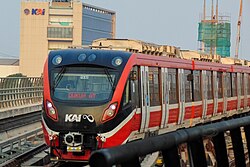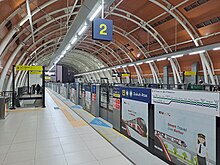The Jabodebek LRT or Greater Jakarta LRT is a light rapid transit system in Greater Jakarta,[4][5][6] the capital city of Indonesia, as well as the adjacent areas of West Java,[7] within the Jakarta Metropolitan area. It was implemented by the central government, and operated by Kereta Api Indonesia (KAI), the system connects the Jakarta city center with suburbs in Greater Jakarta such as Bogor, Depok and Bekasi, hence its acronym Jabodebek.[8]
| Jabodebek LRT | ||||||||||||||||||||||||||||||||||||||||||||||||||||||||||||||||||||||||||||||||||||||||||||||||||||||||||||||||||||||||||||||||||||||||||||||||||||||||||||||||||||||||||||||||||||||||||||||||||||||||||||||||||||||||||||||||
|---|---|---|---|---|---|---|---|---|---|---|---|---|---|---|---|---|---|---|---|---|---|---|---|---|---|---|---|---|---|---|---|---|---|---|---|---|---|---|---|---|---|---|---|---|---|---|---|---|---|---|---|---|---|---|---|---|---|---|---|---|---|---|---|---|---|---|---|---|---|---|---|---|---|---|---|---|---|---|---|---|---|---|---|---|---|---|---|---|---|---|---|---|---|---|---|---|---|---|---|---|---|---|---|---|---|---|---|---|---|---|---|---|---|---|---|---|---|---|---|---|---|---|---|---|---|---|---|---|---|---|---|---|---|---|---|---|---|---|---|---|---|---|---|---|---|---|---|---|---|---|---|---|---|---|---|---|---|---|---|---|---|---|---|---|---|---|---|---|---|---|---|---|---|---|---|---|---|---|---|---|---|---|---|---|---|---|---|---|---|---|---|---|---|---|---|---|---|---|---|---|---|---|---|---|---|---|---|---|---|---|---|---|---|---|---|---|---|---|---|---|---|---|---|---|
 | ||||||||||||||||||||||||||||||||||||||||||||||||||||||||||||||||||||||||||||||||||||||||||||||||||||||||||||||||||||||||||||||||||||||||||||||||||||||||||||||||||||||||||||||||||||||||||||||||||||||||||||||||||||||||||||||||
 Jabodebek LRT arriving from Dukuh Atas station | ||||||||||||||||||||||||||||||||||||||||||||||||||||||||||||||||||||||||||||||||||||||||||||||||||||||||||||||||||||||||||||||||||||||||||||||||||||||||||||||||||||||||||||||||||||||||||||||||||||||||||||||||||||||||||||||||
| Overview | ||||||||||||||||||||||||||||||||||||||||||||||||||||||||||||||||||||||||||||||||||||||||||||||||||||||||||||||||||||||||||||||||||||||||||||||||||||||||||||||||||||||||||||||||||||||||||||||||||||||||||||||||||||||||||||||||
| Owner | Directorate General of Railways (DJKA) of the Ministry of Transportation | |||||||||||||||||||||||||||||||||||||||||||||||||||||||||||||||||||||||||||||||||||||||||||||||||||||||||||||||||||||||||||||||||||||||||||||||||||||||||||||||||||||||||||||||||||||||||||||||||||||||||||||||||||||||||||||||
| Area served | Jakarta, Bogor, Depok, Bekasi | |||||||||||||||||||||||||||||||||||||||||||||||||||||||||||||||||||||||||||||||||||||||||||||||||||||||||||||||||||||||||||||||||||||||||||||||||||||||||||||||||||||||||||||||||||||||||||||||||||||||||||||||||||||||||||||||
| Locale | Greater Jakarta,[1] Indonesia | |||||||||||||||||||||||||||||||||||||||||||||||||||||||||||||||||||||||||||||||||||||||||||||||||||||||||||||||||||||||||||||||||||||||||||||||||||||||||||||||||||||||||||||||||||||||||||||||||||||||||||||||||||||||||||||||
| Transit type | Light rapid transit | |||||||||||||||||||||||||||||||||||||||||||||||||||||||||||||||||||||||||||||||||||||||||||||||||||||||||||||||||||||||||||||||||||||||||||||||||||||||||||||||||||||||||||||||||||||||||||||||||||||||||||||||||||||||||||||||
| Number of lines | 2 | |||||||||||||||||||||||||||||||||||||||||||||||||||||||||||||||||||||||||||||||||||||||||||||||||||||||||||||||||||||||||||||||||||||||||||||||||||||||||||||||||||||||||||||||||||||||||||||||||||||||||||||||||||||||||||||||
| Number of stations | 18 (first phase) | |||||||||||||||||||||||||||||||||||||||||||||||||||||||||||||||||||||||||||||||||||||||||||||||||||||||||||||||||||||||||||||||||||||||||||||||||||||||||||||||||||||||||||||||||||||||||||||||||||||||||||||||||||||||||||||||
| Daily ridership | 87.852[2] | |||||||||||||||||||||||||||||||||||||||||||||||||||||||||||||||||||||||||||||||||||||||||||||||||||||||||||||||||||||||||||||||||||||||||||||||||||||||||||||||||||||||||||||||||||||||||||||||||||||||||||||||||||||||||||||||
| Headquarters | Bekasi, Indonesia | |||||||||||||||||||||||||||||||||||||||||||||||||||||||||||||||||||||||||||||||||||||||||||||||||||||||||||||||||||||||||||||||||||||||||||||||||||||||||||||||||||||||||||||||||||||||||||||||||||||||||||||||||||||||||||||||
| Website | lrtjabodebek | |||||||||||||||||||||||||||||||||||||||||||||||||||||||||||||||||||||||||||||||||||||||||||||||||||||||||||||||||||||||||||||||||||||||||||||||||||||||||||||||||||||||||||||||||||||||||||||||||||||||||||||||||||||||||||||||
| Operation | ||||||||||||||||||||||||||||||||||||||||||||||||||||||||||||||||||||||||||||||||||||||||||||||||||||||||||||||||||||||||||||||||||||||||||||||||||||||||||||||||||||||||||||||||||||||||||||||||||||||||||||||||||||||||||||||||
| Began operation | August 28, 2023 | |||||||||||||||||||||||||||||||||||||||||||||||||||||||||||||||||||||||||||||||||||||||||||||||||||||||||||||||||||||||||||||||||||||||||||||||||||||||||||||||||||||||||||||||||||||||||||||||||||||||||||||||||||||||||||||||
| Operator(s) | ||||||||||||||||||||||||||||||||||||||||||||||||||||||||||||||||||||||||||||||||||||||||||||||||||||||||||||||||||||||||||||||||||||||||||||||||||||||||||||||||||||||||||||||||||||||||||||||||||||||||||||||||||||||||||||||||
| Character | Elevated | |||||||||||||||||||||||||||||||||||||||||||||||||||||||||||||||||||||||||||||||||||||||||||||||||||||||||||||||||||||||||||||||||||||||||||||||||||||||||||||||||||||||||||||||||||||||||||||||||||||||||||||||||||||||||||||||
| Number of vehicles | 31 six-car INKA trainsets | |||||||||||||||||||||||||||||||||||||||||||||||||||||||||||||||||||||||||||||||||||||||||||||||||||||||||||||||||||||||||||||||||||||||||||||||||||||||||||||||||||||||||||||||||||||||||||||||||||||||||||||||||||||||||||||||
| Headway | 10 minutes (peak) 20 minutes (off-peak)[3] | |||||||||||||||||||||||||||||||||||||||||||||||||||||||||||||||||||||||||||||||||||||||||||||||||||||||||||||||||||||||||||||||||||||||||||||||||||||||||||||||||||||||||||||||||||||||||||||||||||||||||||||||||||||||||||||||
| Technical | ||||||||||||||||||||||||||||||||||||||||||||||||||||||||||||||||||||||||||||||||||||||||||||||||||||||||||||||||||||||||||||||||||||||||||||||||||||||||||||||||||||||||||||||||||||||||||||||||||||||||||||||||||||||||||||||||
| System length | 44.5 km (27.7 mi) (first phase) | |||||||||||||||||||||||||||||||||||||||||||||||||||||||||||||||||||||||||||||||||||||||||||||||||||||||||||||||||||||||||||||||||||||||||||||||||||||||||||||||||||||||||||||||||||||||||||||||||||||||||||||||||||||||||||||||
| Track gauge | 1,435 mm (4 ft 8+1⁄2 in) standard gauge | |||||||||||||||||||||||||||||||||||||||||||||||||||||||||||||||||||||||||||||||||||||||||||||||||||||||||||||||||||||||||||||||||||||||||||||||||||||||||||||||||||||||||||||||||||||||||||||||||||||||||||||||||||||||||||||||
| Electrification | 750 V DC third rail | |||||||||||||||||||||||||||||||||||||||||||||||||||||||||||||||||||||||||||||||||||||||||||||||||||||||||||||||||||||||||||||||||||||||||||||||||||||||||||||||||||||||||||||||||||||||||||||||||||||||||||||||||||||||||||||||
| Top speed | 90 km/h (56 mph) | |||||||||||||||||||||||||||||||||||||||||||||||||||||||||||||||||||||||||||||||||||||||||||||||||||||||||||||||||||||||||||||||||||||||||||||||||||||||||||||||||||||||||||||||||||||||||||||||||||||||||||||||||||||||||||||||
| ||||||||||||||||||||||||||||||||||||||||||||||||||||||||||||||||||||||||||||||||||||||||||||||||||||||||||||||||||||||||||||||||||||||||||||||||||||||||||||||||||||||||||||||||||||||||||||||||||||||||||||||||||||||||||||||||
Operation of the Jabodebek LRT was initially targeted to begin in 2019. However, the line was hampered by numerous delays. It commenced official commercial operations on 28 August 2023.[9]
History
Background

The Jabodebek light rapid transit project is aimed to tackle Jakarta's high road traffic congestion. The northern section of the LRT project partly replaces the Jakarta Monorail project which has been cancelled.[10]
The monorail project in Jakarta was planned since the early 2000s. Construction commenced in 2004 but immediately stalled due to insufficient funding. In 2005 the initial pylons were constructed. However, the project was abandoned altogether in 2008, leaving the unfinished pylons blocking the main roads. The monorail line design, including the Green loop line and Blue line gained criticism as it only connected shopping malls in Jakarta's city center and would not connect to Jakarta's suburbs which desperately need transportation infrastructure, and thus would not be useful for Jakartan commuters. Transportation experts deemed that the city center monorail project would not address Jakarta's traffic problems, but would only serve as a novelty tourists' ride.[11] To answer the need for commuter infrastructure, a consortium of five state owned enterprises, led by PT Adhi Karya (previously part of the Jakarta Monorail consortium), proposed the construction of a 39.036 km (24.256 mi) monorail line connecting Cibubur-Cawang-Kuningan and Bekasi-Cawang across Greater Jakarta.[12] The line will connect the 'Green' and 'Blue' lines originally planned by PT Jakarta Monorail to Jakarta's suburbs Cibubur and Bekasi.[13]
Replaced to light rapid transit
In 2013, the Jakarta monorail project was revived and relaunched. In mid-2014 however, the project was stalled after a disagreement between PT Jakarta Monorel, the developer/operator, and the Jakarta Municipal Government over land acquisition for the depot as well as the station designs.[14] Following the disagreements, by 2015 the Jakarta Municipal Government terminated its contract with PT Jakarta Monorel; thus monorail project was disbanded altogether. The numerous stalled monorail support poles will be used by state-owned construction company PT Adhi Karya to develop Jakarta's light rapid transit instead.[10] The shift of choice from monorail to a traditional rapid transit system was based on several considerations; compared to monorail, LRT has higher passenger capacity, simpler intersection and switching system, and cheaper maintenance cost.
Lines
Cibubur Line | ||||||||||||||||||||||||||||||||||||||||||||||||||||||||||||||||||||||||||||||||||||||||||||||||||||||||||||||||||||||||||||||||||||||||||||||||||||||||||||||||||||||||||||||||||||||
|---|---|---|---|---|---|---|---|---|---|---|---|---|---|---|---|---|---|---|---|---|---|---|---|---|---|---|---|---|---|---|---|---|---|---|---|---|---|---|---|---|---|---|---|---|---|---|---|---|---|---|---|---|---|---|---|---|---|---|---|---|---|---|---|---|---|---|---|---|---|---|---|---|---|---|---|---|---|---|---|---|---|---|---|---|---|---|---|---|---|---|---|---|---|---|---|---|---|---|---|---|---|---|---|---|---|---|---|---|---|---|---|---|---|---|---|---|---|---|---|---|---|---|---|---|---|---|---|---|---|---|---|---|---|---|---|---|---|---|---|---|---|---|---|---|---|---|---|---|---|---|---|---|---|---|---|---|---|---|---|---|---|---|---|---|---|---|---|---|---|---|---|---|---|---|---|---|---|---|---|---|---|---|
| ||||||||||||||||||||||||||||||||||||||||||||||||||||||||||||||||||||||||||||||||||||||||||||||||||||||||||||||||||||||||||||||||||||||||||||||||||||||||||||||||||||||||||||||||||||||
Bekasi Line | |||||||||||||||||||||||||||||||||||||||||||||||||||||||||||||||||||||||||||||||||||||||||||||||||||||||||||||||||||||||||||||||||||||||||||||||||||||||||||||||||||||||||||||||||||||||||||||
|---|---|---|---|---|---|---|---|---|---|---|---|---|---|---|---|---|---|---|---|---|---|---|---|---|---|---|---|---|---|---|---|---|---|---|---|---|---|---|---|---|---|---|---|---|---|---|---|---|---|---|---|---|---|---|---|---|---|---|---|---|---|---|---|---|---|---|---|---|---|---|---|---|---|---|---|---|---|---|---|---|---|---|---|---|---|---|---|---|---|---|---|---|---|---|---|---|---|---|---|---|---|---|---|---|---|---|---|---|---|---|---|---|---|---|---|---|---|---|---|---|---|---|---|---|---|---|---|---|---|---|---|---|---|---|---|---|---|---|---|---|---|---|---|---|---|---|---|---|---|---|---|---|---|---|---|---|---|---|---|---|---|---|---|---|---|---|---|---|---|---|---|---|---|---|---|---|---|---|---|---|---|---|---|---|---|---|---|---|---|
| |||||||||||||||||||||||||||||||||||||||||||||||||||||||||||||||||||||||||||||||||||||||||||||||||||||||||||||||||||||||||||||||||||||||||||||||||||||||||||||||||||||||||||||||||||||||||||||
In 2015, it was announced that the Indonesian Cabinet Secretary has endorsed the plan to build three light rail transit lines.[15][16] Total investment cost of this project is estimated to reach 23.8 trillion rupiah (1.8 billion US dollars).[17]
There are two lines on the system:
 Cibubur Line (Dukuh Atas–Harjamukti) (initially Cawang–Harjamukti)[18]
Cibubur Line (Dukuh Atas–Harjamukti) (initially Cawang–Harjamukti)[18]- Station names: Dukuh Atas – Setiabudi – Rasuna Said – Kuningan – Pancoran – Cikoko – Ciliwung – Cawang – TMII (Taman Mini Indonesia Indah) – Kampung Rambutan – Ciracas – Harjamukti
 Bekasi Line (Dukuh Atas–Jatimulya) (initially Cawang–Jatimulya)[18]
Bekasi Line (Dukuh Atas–Jatimulya) (initially Cawang–Jatimulya)[18]- Station names: Dukuh Atas – Setiabudi – Rasuna Said – Kuningan – Pancoran – Cikoko – Ciliwung – Cawang – Jati Bening Baru – Cikunir 1 – Cikunir 2 – Bekasi Barat – Jatimulya
Technically there are three line segments built (with Dukuh Atas – Cawang segment counted as a separate line),[18] however only two lines would be operated.
The construction phase of extension for the planned route Grogol–Pesing–Rawa Buaya–Kamal Raya–Dadap–Soekarno–Hatta International Airport was proposed, but was not mentioned in the Presidential Regulation No. 98 of 2015 which sets the legal framework for state funding.[16]
Phase 1
Phase 1 of the construction consists the entirety of Line 2 (Cawang–Bekasi Timur), part of Line 1 (Cibubur–Cawang–Baranangsiang) and Line 3 (Cawang-Dukuh Atas-Senayan). The first phase will cost 11.9 trillion rupiah (approx. USD 903.6 million). It will be 43.3 kilometres (26.9 mi) long, consisting of 18 stations.[19]
- Phase 1A (Cibubur–Cawang–Dukuh Atas): 24.8 km (15.4 mi)
- Phase 1B (Cawang–Bekasi Timur): 18.5 km (11.5 mi)
Construction of Phase 1 began on 9 September 2015 and was initially predicted to be operational by early 2018, in time for the 2018 Asian Games. However, due to funding, restructuring and land acquisition issues, the project has failed to meet the deadline.
As of August 2021, construction progress has reached 86.57% (93.88% for Cibubur–Cawang, 86.87% for Cawang–Dukuh Atas and 91.58% for Cawang–Bekasi Timur).
The LRT's public free trial run, similar to the Jakarta MRT, is planned started on 12 July 2023, with commercial operations slated to begin on 17 August 2023.[20] The trial lasted until 17 July, before it was halted for a software upgrade.[21]
Phase 2
Phase 2 will extend Line 1 southwards, from Cibubur to Bogor Baranangsiang, and also extending from the other end from Dukuh Atas to Palmerah and Senayan. It is currently in the planning stage.[22]
Ridership

The system carried 6,475 passengers on its opening day, 96,426 passengers within four days of opening,[23] and over 620,000 passengers by 13 September.[24] The Indonesian Ministry of Transport set a target of 120,000 daily passengers in the short term, and 500,000 within the medium term.[25] On 16 September, the amount of daily trips was increased from 158 to 202, with extended operating hours.[24] However, ridership keeps declining to 34,382 in mid-October due to the end of promotional fare of Rp 5,000 and decreased trips due to the maintenance process for 15 of the 31 available trainsets.[26]
Incidents
- A collision of two set of trains occurred during testing phase on 25 October 2021 between Harjamukti station and Ciracas station. Neither train was occupied with passengers.[27] As a result, the two trainsets involved in the collision were badly damaged, and the driver who was driving the train suffered minor injuries.[28][29] The NTSC said that the cause of this incident was human error due to the engineer playing with a cellphone.[30]
- On 30 August 2023, the system's third day of operations, several losses of power caused passengers to be trapped inside stopped trains with no air conditioning.[31]
See also
References
External links
- Adhi Karya:Jakarta LRT environmental impact assessment (in Indonesian)
- Jakarta LRT Progress video per May 2018









